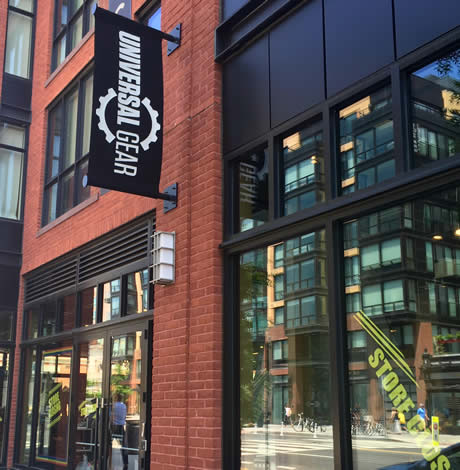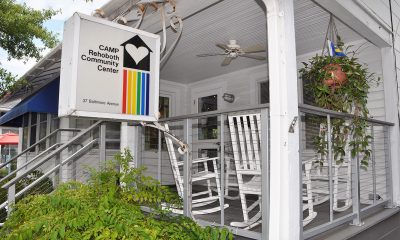Financial
A striking new ‘View’ on 14th Street

David Franco, a longtime local entrepreneur who co-owns Level 2 Development, opened View 14, a 185-unit apartment building in the bustling 14th and U corridor. (DC Agenda photo by Michael Key)
David Franco laughs as he recalls his foray into the entrepreneurial arena. It was 1989 and his good friend, John Guggenmos, was pulling together a group of investors to buy the nightclub Tracks. Franco, a fresh-faced 24-year-old, could not have known that Tracks would shortly experience its heyday and become the focal point of D.C.’s gay nightlife scene, making it a hugely profitable venture, but he smelled opportunity. Or at the very least a really good time. He was ready to jump at the chance.
There was just one snag: “I was not out at the time.”
Franco wasn’t among the legions of gay men and lesbians who came to D.C. to explore and embrace life outside the closet. The recent University of Maryland graduate was a native Washingtonian who had never lived anywhere else. He and his four brothers worked for the family business, a chain of discount department stores run by their father, and they all lived within a mile of each other in the Maryland suburbs. How would his family, especially his Orthodox Jewish father, react to having a family member who was not only gay but owned a gay nightclub?
“I went to my father and said, ‘Dad, I have this opportunity and the opportunity requires me to leave the family business.’” When his father asked what the opportunity was, Franco forced the words out. “I said, ‘I have the opportunity to go in with a group of guys to buy a [gay] nightclub.’ I thought my father was going to hit the roof. But instead he said, ‘If this is going to make you happy, you have my blessing.’”
The Tracks venture was the first step along a career path that would see Franco launch with his Tracks associates a new gay establishment in D.C., Trumpets restaurant, and with business partner Keith Clark start Universal Gear, a chain of clothing stores popular with gay men. Those accomplishments, however, were dwarfed with the opening last month of View 14, a $90 million 185-unit apartment building that he and business partner Jeff Blum developed and built through their real estate firm, Level 2 Development.
The building’s interior was designed in collaboration with local furniture store owners Jason Claire and Eric Kole of Vastu and has the feel of a boutique hotel: funky but modern, stylish with some flashes of whimsy. It boasts the usual upscale finishes like granite countertops and stainless steel appliances and an enviable array of amenities, some the kind you would expect in a new luxury building – roof decks with Weber grills, a party room, 24-hour concierge service, fitness center, underground parking – but some you might not have seen elsewhere, including a sculpture garden, yoga studio, fully loaded theater, and a screen in the cavernous lobby that tells you when the next green and yellow line trains will be arriving at the U Street Metro Station.
Franco likens View 14 itself to a “giant ship coming down 14th Street.” It’s a very fitting image, with the sleek and majestic glass, steel and stone structure seeming to glide down the hill from Columbia Heights to the U Street area. How View 14 came to be is a harrowing voyage in itself, fraught with the squalls and swells of a tanking real estate market and the ensuing lending crisis.
It was 2005, and Franco and Blum were finishing their first venture together, the development of a 12-unit apartment building on the 1400 block of Chapin Street, N.W., called the Mercury at Meridian Hill Park. The real estate market was moving from high gear into overdrive, Franco said, and the building sold out very quickly. Flush with excitement, the two decided that for their second project together they would go big in order to capitalize on the red hot market.
After losing a bid on a property in the NoMa neighborhood, they set their sights on the Petrovich Auto Repair garage at the corner of 14th Street and Florida Avenue, around the corner from the Mercury. The property was perfectly situated on a hill that would afford stunning views of the city, and was within a stone’s throw of the popular U Street corridor.
Unfortunately, owners Paolo and Pedro Petrovich weren’t exactly jumping at the opportunity.
“They weren’t prepared [to sell] at that time,” said Franco. “They wanted to reinvest [whatever profit they would make from the sale] but didn’t know what to do.”
Undeterred, Franco and Blum made themselves a fixture at the Petroviches’ garage. “One of us would be in there at least once a week, seeing how things were,” often over lunch. “We really cultivated a relationship.” Franco, meanwhile, diligently researched opportunities for the Petroviches to reinvest their money. When the brothers took him up on a suggestion to tour some CVS stores in the Baltimore area, Franco began to feel guardedly optimistic.
Several months later, after a delicate dance with the Petroviches that could only be described as a wooing, complete with the appearance of a rival suitor, Franco and Blum won the sale.
Once that first major hurdle was cleared other challenges followed – finding a suitable architect and investment partner, navigating city bureaucracy to get the requisite permits to build a large scale condo building where an auto repair shop used to be, making expensive arrangements for the grounds to be cleansed of several decades worth of oil and gasoline seepage – but those were overcome with hard work and perseverance.
Franco and Blum quickly found strong support for their project among D.C. politicians, with Mayor Adrian Fenty attending the groundbreaking and Ward 1 Council member Jim Graham stepping in to facilitate communication with Comcast, which had been unresponsive to Franco and Blum’s appeals to discuss with them the relocation of Comcast-owned satellite dish equipment and a signal receiver tower from the View 14 site. Graham would later champion legislation that gave the View 14 project $5.7 million in tax abatement.
The View 14 developers also won kudos from local community leaders and the city government by donating $1 million to the residents of Cresthill Apartments toward the purchase of their building and the formation of a cooperative. This was done as part of their deal with the city, which requires developers to provide affordable housing if they are building a high-density project. Rather than set aside units in the new building for that purpose, as is normally done, the View 14 developers, seeing need in their community, chose instead to donate needed funds to the Cresthill residents, whose building was less than a block away and was soon to be sold on the open market.
“I never will forget the first day I met David,” said Sankofa Cooperative president Sheila Royster, who has lived in the Cresthill Apartments building for 40 years. “He came to my unit and he brought me a plant. I thought that was wonderful. It was a genuine gesture and to me it just demonstrated his respect for us and what we were doing.”
Dark clouds began to loom though as speculation that the housing market was cresting gave way to fears of a housing bubble that could burst at any moment and send property values tumbling. Still, Franco and Blum were confident. More than 1,000 people attended the lavish launch party in September of 2006. Rival developers nervously dubbed View 14 “The Death Star” because it was expected to “suck up all the other condo purchasers in the market,” Franco said. “We were excited.”
Contracts trickled in, a dozen and a half in the first two months, and the cold reality set in: they weren’t selling enough units to finance the start of construction on time. It might be months, or even a year, before they reached that point. If they were able to reach that point.
The two men sat down with their project partners and made the difficult decision to re-engineer View 14 as a rental project. “It was literally the million dollar decision for us,” said Franco. “We had spent a million dollars in marketing and building a sales center.”
Franco said that he and Blum have accepted a letter of intent from a “well-known retail and services establishment in the area” that will use 8,000 square feet of space to expand their facilities.
“The neighborhood is going to be ecstatic when they learn who’s going to be there,” he promises. A signed lease and announcement is expected soon.
Franco is just as ebullient when he talks about the 14th and U Street neighborhood and its future. He points out that the Solea, a condo building directly across 14th Street from View 14, has nearly sold out. And there is just one unit left for sale at Union Row, the massive, 216-unit condo building that also houses Yes! Market, a CVS, and the restaurant Eatonville.
“That speaks volumes to the desirability of this neighborhood,” said Franco.
About 25 leases have been signed so far and the first View 14 residents moved in over Thanksgiving weekend, among them Galan Panger, a 24-year-old gay man who is leasing a studio. Panger, who works in Google’s downtown D.C. office, said he was impressed by the quality of the building’s construction and with the finishes. The amenities solidified the decision to trade in his digs at nearby Union Row for View 14.
“It was nice of them to create these community spaces,” Panger said. “My boyfriend and I have been grilling even though it’s been cold.” They have been sticking to the east roof deck after Franco joked during a tour of the building that it was the gayer of the two rooftop spaces since it has “the more fabulous view.”
Franco himself is one of View 14’s newest tenants, along with his dog; last week he sold his home near Meridian Hill Park and they moved into one of the penthouse units.
Franco sees a wide mix of people coming to View 14, from single young professionals to retired couples. There is also a fair bit of traffic from gay and lesbian renters like Panger, which Franco attributes to a variety of factors, including the fact that the building bears the strong imprint of two openly gay men, he and Blum, as well as the influence of other gay men they know like Claire and Kole of Vastu and Chris Cahill, a good friend of Franco’s who works for Botanical Decorators and came up with the idea for using the courtyard space as a sculpture garden and helped select the sculptures and interior plants.
People, gay and straight alike, Franco observed, appreciate quality and, “not to rely too heavily on stereotypes, but gay men have a natural attention to detail. We as gay men are [attuned] to high style, high design and convenience. This building delivers that.”
Real Estate
In real estate, trust the process
With rates coming down, we could see spring surge in buyers

The average 30-year mortgage rate is falling, little by slowly. With predictions that the rate will continue to adjust downward in the next year or two, there may be a busier spring market than we have seen in the last few year, especially for the DMV market, which has been reeling from thousands of layoffs this past year. The frenzied activity resulting from interest rates close to 3% for some borrowers will probably not occur; however, this spring could add up to be a few notches busier than the last.
What does this mean for buyers and sellers? Lender Tina Del Casale with Waterstone Mortgage says she has seen “low to mid 6’s as the average for conventional loans.” If rates continue downward into the 5% range, there may be more activity than we saw in the last year or two. This could release a little bit of pent up demand.
Many buyers will have found that for whatever reason, their current home is not meeting their needs. Sellers may want to finally take the plunge and put a for sale sign in the yard and online, now that they might find a more reasonable rate on their next home. This winter can be an opportunity to assess financial situations, home conditions, and optimize one’s chances to have a sale with more agreeable terms, or put one’s best foot forward in an offer. In addition to checking with a lender or favorite handy person, let’s review what sellers and buyers typically spend their energy negotiating while enjoying the lovely process called “going under contract”:
- Timelines – Sellers might want to have their house solidly under contract (papers signed, thumbs up from the lenders, all inspection items decided upon and settled) so that they can put an offer down on a new home, and then negotiate that timeline with the other sellers. Remember, making a move is not only about the buyer taking possession of a new home, but also about the sellers figuring out their situation as well.
- Sale Price – unfortunately for buyers, in the eyes of most sellers, “money talks.” So, in a non-competitive situation, a seller might be happy to just get one offer at a price that was within the desired range. As soon as another interested buyer enters the equation, it can become a little bit like RuPaul’s Drag Race, and one will have to lip sync for one’s life, honey! And only one buyer will get to hear the words, “condragulations!”
- Tone/Vibes/Energy in the Room – Remember: Human beings are emotional creatures. All of us have feelings. And all of us want to put energy into situations where we feel appreciated, where a level of self-awareness exists, and a sense that each side is trying one’s hardest to act in good faith. The best transactions I saw were where a little grace was the “grease on the wheels” of the transaction. Occasionally, a buyer had cold feet and wanted to see the unit a few more times before the settlement date, or a seller forgot to scrub the bathroom with a little extra elbow grease before the settlement date. Life happens; misunderstandings can occur. A wise therapist once said: “You don’t have to like it, but can you allow it?” The tone of one or both parties in the transaction can be what seals the deal, or results in one party exiting the contract. (In the case of the dirty bathroom, the seller left a check with the title company for the buyer to pay a housekeeper to come clean what they couldn’t.)
Joseph Hudson is a referral agent with Metro Referrals. He can be reached at 703-587-0597 or [email protected].
Real Estate
Signs you’ve outgrown self-management of your D.C. rental
Keeping up with local regulations is a struggle

According to rental market statistics from RentCafe, Washington, D.C., remains at the top of the most popular cities for rental properties. With a strong rental market and a growing population, success should be second nature to real estate investors and rental property owners in this area.
As a self-manager of your own rental, if you’re not enjoying the profitability and the earnings that this market can provide, it might be time to look for professional management.
There are certain signs that show property owners have outgrown self-management. We’re exploring those today, and inviting DIY landlords to consider the benefits that come with a partnership with a professional property management company in Washington, D.C.
Washington, D.C., is known for having a complex and ever-changing regulatory environment. There are strict tenant rights, rent control laws, and specific rules related to property maintenance such as mold, lead based paint hazards, among others. The Rental Housing Act of 1985 is strictly enforced, and under this program, there are specific rules regarding rent adjustments, dispute resolution, and eviction protections.
Fair housing laws need complete compliance, security deposits have strict timelines, and habitability standards are in place to ensure tenants are living in a home that’s safe and well-maintained.
Staying on top of these rules can be time-consuming and difficult. Violating even a small regulation unintentionally can result in fines or legal action. It’s critical to stay compliant, and if you find yourself struggling to keep up with the evolving laws and regulations, it’s a clear sign that you may need professional help. Property managers can reduce the risk and liability of making a legal mistake.
Financial Returns are Underwhelming
A lot of self-managing landlords choose to lease, manage, and maintain their own properties because they don’t want to pay a management fee. We get it. Keeping more of your money seems like the best way to increase profitability.
But, here’s the reality of it: property managers can help you earn more and spend less on your investment, increasing your earnings and your ROI. In fact, a good property manager can often earn enough additional net revenue for the owner to pay for that fee over a year.
Property managers are experienced at maximizing the financial performance of rental properties. We can help:
- Optimize rental income
- Reduce vacancy rates
- Lower maintenance costs through established vendor relationships
- Recommend improvements for higher values
Ultimately, a good property manager will ensure that your property is being run efficiently. We will use our expertise to ensure your property is earning what it should.
Maintenance and Repairs Are Taking Up Too Much Time
Maintenance challenges are not unique to self-managing rental property owners. We deal with them, too, as professional property managers. We respond to plumbing issues and appliance malfunctions, we take calls in the middle of the night when a sewer is backing up, and we work hard to protect properties against deterioration and general wear and tear.
This can be overwhelming, especially when it comes to finding vendors and service professionals that are both affordable and provide quality service. Plumbers, electricians, HVAC technicians, and even landscapers and cleaners are in high demand in Washington, D.C. But maintenance at your rental property cannot wait. It’s essential to the value and condition of your investment as well as to the product you are selling.
It’s time to work with a professional property manager if you’re having trouble finding vendors or if you’re struggling to keep up with maintenance requests. We have systems for emergency responses, routine repairs, and preventative services.
Tenant Screening Is Becoming More Difficult and Time-Consuming
Finding good tenants is one of the most critical aspects of rental property management. But in our home of Washington, D.C. we have one of the most regulated rental markets in the country. The tenant screening process has become increasingly complex, highly restricted, and time-intensive.
Many property owners are surprised to learn that there are more limitations than ever on what can be screened, what information can be used in making a decision whom to rent to, and how screening decisions must be documented. Federal and local laws tightly regulate the use of credit histories, criminal background records, income verification, and even eviction records. Staying compliant is not optional. Failure to follow these rules can open the door to discrimination claims, administrative complaints, substantial fines, or even lawsuits.
That’s why rushing or relying on outdated methods can easily result in selecting the wrong resident or worse, unintentionally violating DC’s Human Rights Act or federal Fair Housing laws.
Problematic tenants often become evident only after move-in: lease breaks, chronic late payments, noise complaints, and property damage. When these patterns appear repeatedly, it is often a sign that the screening process is not sufficiently structured.
Why Professional Screening Matters
Professional property managers have systems in place to perform thorough, legally compliant screening while avoiding oversteps that could violate the regulations. Professional property managers use trusted screening platforms and follow written processes that keep owners protected and ensure fairness for applicants.
Columbia Property Management’s screening process includes:
- Credit Report Review
Evaluating credit patterns, payment reliability, and debt load while complying with restrictions on how data can be used. - Rental History Verification
Contacting prior landlords and reviewing national eviction databases—keeping in mind that some jurisdictions like the District of Columbia limit how far back eviction data can be seen, must less considered. - Background ChecksReviewing public records in a manner consistent with DC’s Human Rights Act and federal guidance on criminal history usage. Not all criminal records can be considered in rental decisions, and timing rules often apply.
- Income & Employment Verification
Confirming applicants can afford the rent and other monthly expenses based on their income, without ruling out certain income in a discriminatory way (e.g., vouchers, subsidies, or lawful alternative forms of income). There are many intentional steps conducted by professional property managers under a framework that ensures decisions are based on objective criteria, applied consistently, and fully aligned with the latest federal and DC regulations.
Your Property Is Sitting Vacant for Longer Periods
While current rental market dynamics are starting to show the effects of federal workforce layoffs and the worsening local economy, the vacancy rate in Washington, D.C., is relatively low, compared to the national average. According to a news report from WTOP, the local vacancy rate is just 6%, and there are an average of seven applications for every available rental unit.
A vacant rental property can quickly become a financial drain. Whether you own a condo near Dupont Circle or a single-family home in one of Capitol Hill’s neighborhoods, every day your property sits empty means lost income. While the D.C. market is generally competitive, the reality is that there are always fluctuations in demand based on seasons, neighborhood desirability, and even economic trends.
If you’re struggling to fill your rental quickly, it might be a sign that you need to re-evaluate your approach. An experienced property management company has a marketing strategy in place to keep vacancy periods as short as possible. From professional photos and listings to leveraging established networks, they can help ensure that your property is rented quickly, reducing the amount of time it sits vacant.
While managing a rental property in Washington, D.C., can be rewarding, it’s also challenging. As your property portfolio grows or the demands of your life or the demands of being a landlord increase, it’s helpful to recognize when it’s time to step back and let a professional handle the day-to-day tasks.
From navigating complex local regulations to ensuring your property remains occupied and well-maintained, there are many reasons why rental property owners in Washington, D.C., outgrow self-management. If any of these signs resonate with you, consider partnering with a property management company like ours to ensure that your rental investment continues to thrive without the stress and burnout of self-management.
We’d love to be your Washington, D.C., property management partner and resource. Please contact us at 888-857-6594 or ColumbiaPM.com
Scott Bloom is owner and Senior Property Manager, Columbia Property Management.
Real Estate
Tips for LGBTQ buyers, sellers during holidays
A powerful and overlooked window for real estate transactions

The holiday season is a magical time, filled with celebration, travel, connection, and reflection. It also happens to be a powerful — and often overlooked — window for both buying and selling real estate. For members of the LGBTQ+ community, shopping for a new home or preparing to list a property during the holidays comes with opportunities, challenges, and important considerations that deserve thoughtful attention.
Whether you’re preparing to make a move as a same-sex couple, searching for safe and affirming neighborhoods, or hoping to secure the best possible price for your home sale before the new year, the holidays can offer unique advantages. With an inclusive approach, LGBTQ+ friendly resources, and the right professional guidance, this season can be a strategic and rewarding time to take your next real estate step.
Below are actionable tips, insights, and resources specifically tailored to LGBTQ+ home buyers and sellers navigating the holiday season.
Why the Holidays Can Be the Right Time
Lower Competition & Motivated Sellers
Because so many people put their real estate plans on pause during November and December, LGBTQ+ home buyers may see lower competition, fewer bidding wars, and sellers who are eager to close before January. This can bring real advantages for first-time gay home buyers or same-sex couples seeking more favorable negotiating terms.
Buyers Are More Serious
If you’re selling your home as an LGBTQ+ individual, remember: holiday buyers tend to be more intentional, financially prepared, and timeline-driven. This can make the sale process smoother.
Holiday Appeal Helps Homes Show Better
Warm lighting, seasonal décor, and neighborhood festivities can enhance curb appeal and emotional impact — which can be especially valuable when selling your home.
Tip #1: Choose LGBTQ-Friendly Representation
Above all else: work with a professional who understands the LGBTQ+ community and the unique concerns LGBTQ+ clients have.
This means choosing:
- a gay realtor
- a lesbian realtor
- an LGBTQ+ friendly real estate agent
Agents who are part of, or deeply familiar with, the LGBTQ+ community can make a tremendous difference in safety, comfort, and confidence throughout the transaction.
For more than 30 years, GayRealEstate.com has been the trusted leader in LGBTQ+ real estate, providing LGBTQ+ home buyers and sellers access to:
- verified LGBTQ+ real estate agents
- same-sex couple home buying experts
- LGBTQ+ friendly realtors near you
- agents experienced in discrimination-related protections
- LGBTQ+ relocation specialists
Whether you’re buying or selling, this starts you on the right path.
Tip #2: Focus on LGBTQ-Friendly Neighborhoods
If you’re buying a home during the holidays, make researching neighborhoods a top priority.
Look for areas known for:
- Inclusion & diversity
- Active local LGBTQ+ groups
- Gay-friendly businesses
- Visible LGBTQ+ community presence
- Supportive schools & services
- Pride events & alliances
Searching online helps — but talking with an LGBTQ+ friendly realtor who knows these neighborhoods firsthand is invaluable.
Also search:
- LGBTQ+ crime statistics
- local anti-discrimination policies
- protections against housing discrimination
- hate crime data
- political climate
- HOA regulations
Your home should feel safe year-round, not just festive in December.
Tip #3: Know Your Legal Protections
Housing discrimination still exists — and LGBTQ+ home buyers and sellers must remain vigilant.
While federal protections exist through the Fair Housing Act (as interpreted to include sexual orientation and gender identity), not all states provide equal protection.
Know your rights around:
- Mortgage discrimination
- Rental screening discrimination
- Sellers refusing offers from LGBTQ+ buyers
- HOA discrimination
- Harassment after move-in
Your agent should be able to assist — but GayRealEstate.com also offers educational guidance and resources for navigating LGBTQ+ legal protections in real estate
Tip #4: Navigate the Emotional Side
For LGBTQ+ buyers and sellers, the holidays can stir up complex feelings:
- family dynamics
- financial pressure
- expectations around marriage or partnership
- relocation stress
- memories tied to a home
Be patient with yourself.
Buying or selling a home is life-changing — honor the emotional journey as much as the financial one.
Tip #5: Take Advantage of Holiday Cost Savings
Buying?
- Lower interest rates may appear around December
- Contractors often discount home inspections & repairs this time of year
- Movers run holiday promotions
Selling?
- Minor seasonal upgrades help tremendously:
- warm lighting
- new evergreen planters
- festive front door accents
- Be careful not to over-decorate — buyers need to see the space clearly
And yes — holiday cookies help.
Tip #6: If You’re Relocating — Plan Ahead
Many LGBTQ+ buyers relocate during the holidays to:
- be closer to family
- move in with a partner
- begin a new job in the new year
If you’re relocating as an LGBTQ+ couple or family:
- research local LGBTQ+ resources
- connect with local LGBTQ+ organizations
- ask your gay real estate agent about local LGBTQ+ clubs, groups, and services
- evaluate long-term safety for LGBTQ+ families
Plan early — December moves get booked fast.
Tip #7: Use Trusted LGBTQ Real Estate Resources
The most important resource of all:
GayRealEstate.com — the #1 dedicated LGBTQ+ real estate resource for over 30 years.
On GayRealEstate.com, you can find:
- LGBTQ+ friendly real estate agents nationwide
- Verified gay and lesbian Realtors
- LGBTQ+ real estate market information
- Same-sex couple home buying guidance
- LGBTQ+ real estate services
- Gay and lesbian friendly neighborhoods
- Relocation tools
- LGBTQ+ home buyer & seller education
No other site offers this level of specialization, expertise, or community connection.
The holidays are more than just a season of celebration — they’re also a meaningful opportunity for LGBTQ+ home ownership, real estate transitions, and new beginnings. Whether you’re a first-time gay home buyer, a same-sex couple selling a home, or an LGBTQ+ family preparing to relocate, you deserve an experience grounded in respect, inclusion, and safety.
With the right preparation — and the right LGBTQ+ friendly real estate agent — your journey can be rewarding, affirming, and filled with new possibilities for the year ahead.
To find an LGBTQ+ real estate agent who understands your needs, visit GayRealEstate.com, the trusted leader in LGBTQ+ real estate services, resources, and representation for over three decades.
Scott Helms is president and owner of Gayrealestate.com.
-

 Congress4 days ago
Congress4 days agoEXCLUSIVE: George Santos speaks out on prison, Trump pardon, and more
-

 The White House4 days ago
The White House4 days agoWhite House deadnames highest-ranking transgender official
-

 Opinions4 days ago
Opinions4 days agoReflecting on six years on the CAMP Rehoboth board
-

 The White House4 days ago
The White House4 days agoAs house Democrats release Epstein photos, Garcia continues to demand DOJ transparency

















